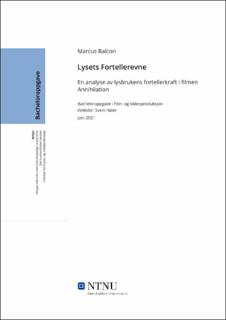| dc.contributor.advisor | Høier, Svein | |
| dc.contributor.author | Balcon, Marcus | |
| dc.date.accessioned | 2021-09-14T16:16:57Z | |
| dc.date.available | 2021-09-14T16:16:57Z | |
| dc.date.issued | 2021 | |
| dc.identifier | no.ntnu:inspera:76749986:21159013 | |
| dc.identifier.uri | https://hdl.handle.net/11250/2776713 | |
| dc.description.abstract | I denne teksten undersøkes lysets bidrag til historiefortellingen i film og hovedsakelig hvordan lys brukes som en viktig del av historiefortellingen i Annihilation (Garland, 2018). Teksten innleder med generelle tanker om lys i film, før den legger et lysteoretisk grunnlag basert på fire lysprinsipper. Disse fire elementene er lyskvalitet, lysretning, type belysning, og farge og temperatur. Analysen av Annihilation (Garland, 2018) gjøres på bakgrunn av kapittelet omhandlende lysteori og et intervju med lysmesteren i filmen, Andy Lowe. Tekstens funn er at lyskvalitet, lysretning, type belysning, og farge og temperatur bidrar til å rette fokus, bygge troverdighet og skape en atmosfære som speiler og forsterker en films handling. | |
| dc.description.abstract | This text examines the contribution of light to the storytelling in film and mainly how light is used as an important part of the storytelling in Annihilation (Garland, 2018). The text begins with general thoughts about light in film, before laying a light theoretical foundation based on four light principles. These four elements are light quality, light direction, type of lighting, and color and temperature. The analysis of Annihilation (Garland, 2018) is done on the basis of the light theory presented and an interview with the light master in the film, Andy Lowe. The text's findings are that light quality, light direction, type of lighting, and color and temperature help to focus, build credibility and create an atmosphere that reflects and enhances a film's story. | |
| dc.language | nob | |
| dc.publisher | NTNU | |
| dc.title | Lysets fortellerevne | |
| dc.type | Bachelor thesis | |
